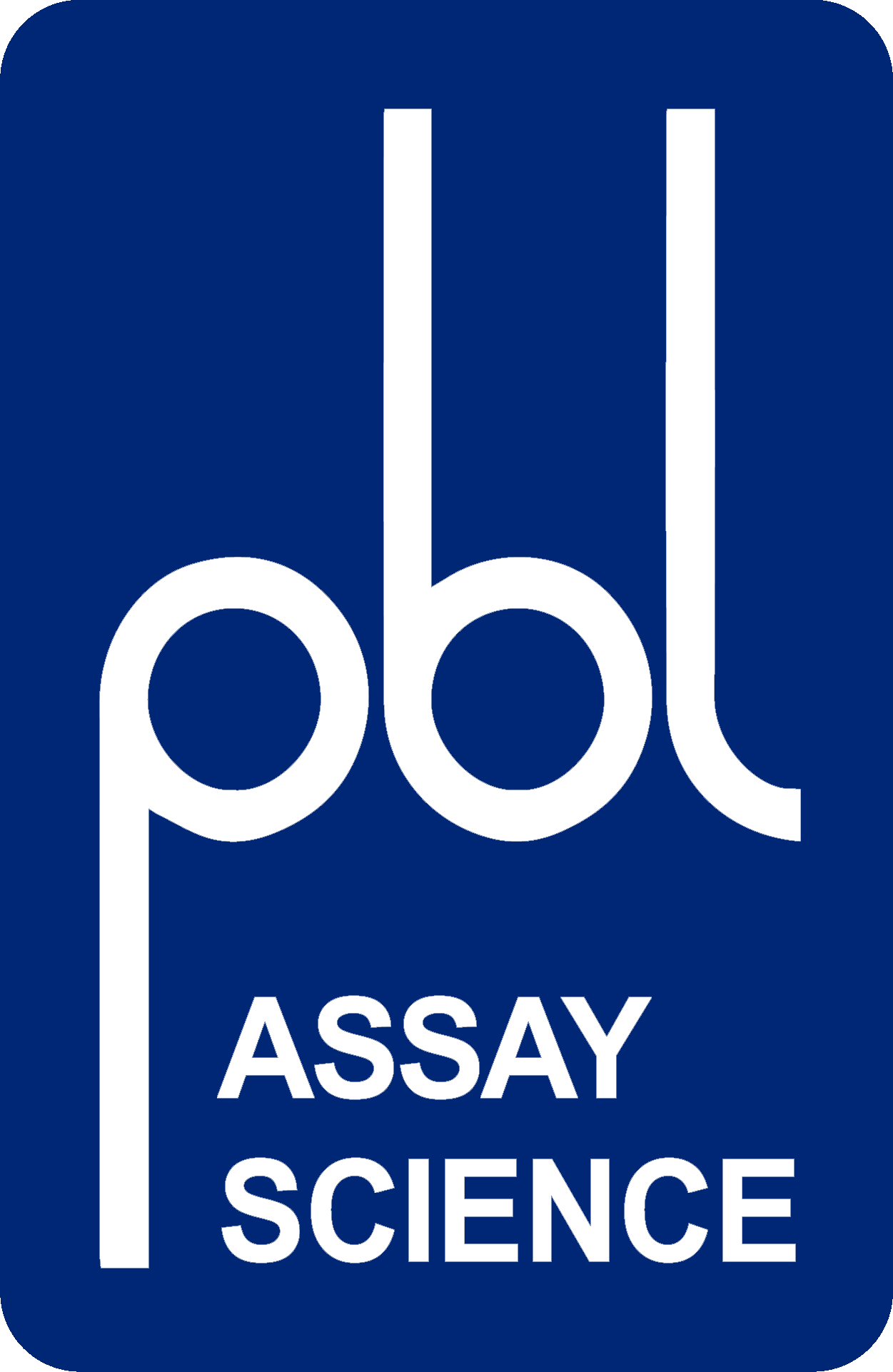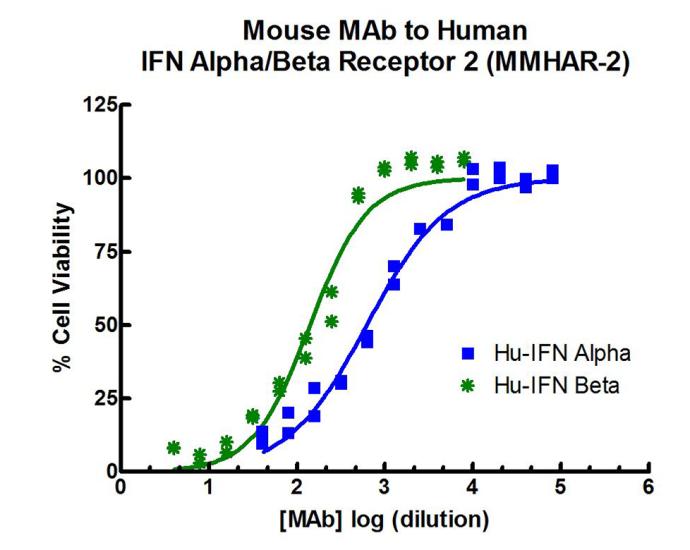Anti-Human IFN-Alpha/Beta Receptor Chain 2, Clone MMHAR-2 (MAb)
Catalog Number: 21385
This well-cited and popular antibody blocks the biological action of Human Type I interferons. It is suitable for use in Type I IFN neutralization, flow cytometry, immunohistochemistry, and immunoprecipitation.
$655.00
Product Info
Specificity Neutralizes human IFN-Alpha receptor; interacts with extracellular domain; binds to human IFN-Alpha receptor with high affinity; blocks biological action of Type I IFNs Tested Application Suggested Applications*
*Please note that these applications are presented for suggested use only and have not been fully evaluated by PBL.
The Type I interferon receptor is a heterodimer consisting of IFNAR1 and IFNAR2. The IFNAR2 subunit provides most of the binding affinity for IFN and IFNAR1 is required for optimum signaling.
Full Product Name: Anti-Human Interferon Alpha/Beta Receptor Chain 2, Clone MMHAR-2 (MAb)
Specifications
| Formulation | Supplied frozen in phosphate-buffered saline (PBS) containing 0.1% Bovine Serum Albumin (BSA) |
|---|---|
| Antigen | Human interferon alpha/beta receptor chain 2 (Human IFNAR2) |
| Isotype | IgG2A |
| Host Species | Mouse |
| Purity | > 95% by SDS-PAGE stained by Coomassie Blue Endotoxin level < 1 EU/μg |
| Bioactivity | Measured by neutralization of interferon in cytopathic effect inhibition assay. |
| Storage | For retention of full activity store at -70°C or below and avoid repeated freeze/thaw cycles |
| Antigen Synonyms | None |
| Clone | MMHAR-2 |
Citations
58 Citations
- Fitzsimmons, L. et al., (2024), "Rickettsia rickettsii virulence determinants RARP2 and RapL mitigate IFN-b signaling in primary human dermal microvascular endotheial cells, mBio, e0345023, PMID: 38445878, DOI: 10.1128/mbio.03450-23 (link)
- Lei, X. et al., (2024), "CD4+T cells produce IFN-I to license cDC1s for induction of cytotoxic T-cell activity in human tumors", Cell Mol Immunol., PMID: 38383773, DOI: 10.1038/s41423-024-01133-1 (link)
- Sala, A., et al., (2023), "A New Phenotype in Candida-Epithelial Cell Interaction Distinguishes Colonization-versus Vulvovaginal Candidiasis-Associated Strains", mBio, e0010723, PMID: 36856418, DOI: 10.1128/mbio.00107-23 (link)
- Malle, L. et al., (2023), "Autoimmunity in Down's syndrome via cytokines, CD4T cells and CD11c+B cells", Nature, PMID: 36813963, DOI: 10.1038/s41586-023-05736-y (link)
- Naesens, L., et al., (2022), "GTF3A mutations predispose to herpes simplex encephalitis by disrupting biogenesis of the host-derived RIG-I ligand RNA5SP141", Sci. Immunol., 7(77):eabq4531, DOI: 10.1126/sciimmunol.abq4531 (link)
- Sawaged, S. et al., (2022). "TBK1 and GABARAP family members suppress Coxsackievirus B infection by limiting viral production and promoting autophagic degradation of vial extracellular vesicles", PLoS Pathog. 18(8):e1010350, PMID: 36044516, DOI: 10.1371/journal.ppat.1010350 (link)
- Werner, M., et al., (2022) "Antiviral Toll-Like Receptor Signal in Non-Parenchymal Liver Cells Is Restricted to TLR3", Viruses, 14:218, DOI: 10.3390/v14020218 (link)
- Yu, C. et al., (2022), "ID2 inhibits innate antiviral immunity by blocking TBK1- and IKKε-induced activation of IRF3", Science Signaling, 15:715, DOI: 10.1126/scisignal.abh0068 (link)
- Facchini, F.A., et al. (2021). Synthetic Glycolipids as Molecular Vaccine Adjuvants: Mechanism of Action in Human Cells and In Vivo Activity, J. Med. Chem., DOI:10.1021/acs.jmedchem.1c00896 (link)
- Sabree, SA., et al. (2020). Direct and indirect immune effecrs of CMP-001, a virus-like particle containing a TLR-9 agnoist, Journal of ImmunoTherapy of Cancer, 9:e002484, DOI: 10.1136/jitc-2021-002484. (link)
- Colpitts, Che, et al. (2020). Hepatitis C virus exploits cyclophilin A to evade PKR. eLife, 25 pgs. PMID: 32539931. (link)
- Kullaya, Vesla Ignace (2019). The interplay between platelets, infections, and inflammation. Radboud University Nijmegen, 181 pgs. PMID: no PMID. (link)
- Merindol, Natacha, et al. (2018). HIV-1 capsids from B27/B57+ elite controllers escape Mx2 but are targeted by TRIM5α, leading to the induction of an antiviral state. PLOS Pathogens, 22 pgs. PMID: 30419009. (link)
- Zavala, Kathryn, et al. (2018). Intrinsic activation of the vitamin D antimicrobial pathway by M. leprae infection is inhibited by type I IFN. PLOS Neglected Tropical Diseases, 15 pgs. PMID: 30300363. (link)
- Lucifora, et al. (2018). Direct antiviral properties of TLR ligands against HBV replication in immune-competent hepatocytes. Scientific Reports, 11 pgs. PMID: 29599452. (link)
- Scholte, Florine, et al. (2017). Crimean-Congo Hemorrhagic Fever Virus suppresses Innate Immune Responses via a Ubiquitin and ISG15 Specific Protease. Cell Reports, 24 pgs. PMID: 28877473. (link)
- Zhu, Zhe, et al. (2017). Zika virus has oncolytic activity against glioblastoma stem cells. JEM, 15 pgs. PMID: 28874392. (link)
- Diaz-Rodriguez, Yildian, et al. (2017). In vitro differentiated plasmacytoid dendritic cells as a tool to induce anti-leukemia activity of natural killer cells. Cancer Immunology, Immunotherapy, 14 pgs. PMID: 28555259. (link)
- Wang, Ben, et al. (2017). A Conserved Residue, Tyrosine (Y) 84, in H5N1 Influenza A Virus NS1 Regulates IFN Signaling Responses to Enhance Viral Infection. Viruses, 21 pgs. PMID: 28498306. (link)
- Bowen, James, et al. (2017). Zika Virus Antagonizes Type I Interferon Responses during Infection of Human Dendritic Cells. PLOS Pathogens, 30 pgs. PMID: 28152048. (link)
- Schwartz, Jordan (2017). Elucidation of the Plasmacytoid Dendritic Cell Response to HIV-1. University of Toronto, 190 pgs. PMID: no PMID. (link)
- Ma, Tong-Cui, et al. (2016). Soybean-derived Bowman-Birk Inhibitor (BBI) Inhibits HIV Replication in Macrophages. Scientific Reports, 10 pgs. PMID: 27734899. (link)
- Cordeau, Martine, et al. (2016). Efficient Killing of High Risk Neuroblastoma Using Natural Killer Cells Activated by Plasmacytoid Dendritic Cells. PLOS One, 17 pgs. PMID: 27716850. (link)
- Yin, Wenwei, et al. (2016). Functional dichotomy of Vδ2 γδ T cells in chronic hepatitis C virus infections: role in cytotoxicity but not for IFN-γ production. Scientific Reports, 12 pgs. PMID: 27192960. (link)
- Saidi, Hela, et al. (2016). HMGB1 Is Involved in IFN-α Production and TRAIL Expression by HIV-1-Exposed Plasmacytoid Dendritic Cells: Impact of the Crosstalk with NK Cells. PLOS Pathogens, 30 pgs. PMID: 26871575. (link)
- Thomann, Sabrina, et al. (2015). Combined cytotoxic activity of an infectious, but non-replicative herpes simplex virus type 1 and plasmacytoid dendritic cells against tumour cells. Immunology, 12 pgs. PMID: 26194553. (link)
- Kyriakidis, et al. (2014). TLR3 Stimulation Promotes Ro52/TRIM21 Synthesis and Nuclear Redistribution in Salivary Gland Epithelial Cells, Partially via Type I Interferon Pathway. Clinical & Experimental Immunology, 13 pgs. PMID: 25098814. (link)
- Bowers, et al. (2014). Immune Suppression by Neutrophils in HIV-1 Infection: Role of PD-L1/PD-1 Pathway. PLOS One, 9 pgs. PMID: 24626392. (link)
- Tsugawa, et al. (2014). Critical Role of Interferon-alpha Constitutively Produced in Human Hepatocytes in Response to RNA Virus Infection. PLOS One, 9 pgs. PMID: 24587086. (link)
- Schijf, et al. (2013). Respiratory Syncytical Virus Induced Type I IFN Production by pDC is Regulated by RSV-Infected Airway Epithelial Cells, RSV-Exposed Monocytes and Virus Specific Antibodies. PLOS One, 18 pgs. PMID: 24303065. (link)
- Jing, et al. (2014). Intracellular Poly(I:C) Initiated Gastric Adenocarcinoma Cell Apoptosis and Subsequently Ammeliorated NK Cell Functions. Journal of Interferon & Cytokine Research. PMID: 24032591. (link)
- Rodrigues, et al. (2013). Candida albicans Delays HIV-1 Replication in Macrophages. PLOS One, 11 pgs. PMID: 24009706. (link)
- Kuri, et al. (2013). Influenza A Virus-Mediated Priming Enhances Cytokine Secretion by Human Dendritic Cells Infected with Streptococcus pneumoniae. Cellular Microbiology, 16 pgs. PMID: 23421931. (link)
- Dickensheets, et al. (2013). Interferon-lambda Induces Signal Transduction and Gene Expression in Human Hepatocytes, but Not in Lymphocytes or Monocytes. JLB. PMID: 23258595. (link)
- Patel, et al. (2012). Uterine Epithelial Cells Specifically Induce Interferon-Stimulated Genes in Response to Polyinosinic-Polycytidylic Acid Independently of Estradiol. PLOS One, 11 pgs. PMID: 22558189. (link)
- Rodrigues, et al. (2011). Epithelial Cells Activate Plasmacytoid Dendritic Cells Improving Their Anti-HIV Activity. PLOS One, 13 pgs. PMID: 22163327. (link)
- Pascutti, et al. (2011). Interplay Between Modified Vaccinia Virus Ankara and Dendritic Cells: Phenotypic and Functional Maturation of Bystander Dendritic Cells. JVI, 14 pgs. PMID: 21411535. (link)
- Inglefield, et al. (2008). TLR7 agonist 852A inhibition of tumor cell proliferation is dependent on plasmacytoid dendritic cells and type I IFN. Journal of Interferon & Cytokine Research. PMID: 18439103. (link)
- Moll, et al. (2008). Neutralizing type I IFN antibodies trigger an IFN-like response in endothelial cells. Journal of Immunology, 8 pgs. PMID: 18390705. (link)
- Davis, Ann, et al. (2008). A T-bet-independent role for IFN-α/β in regulating IL-2 secretion in human CD4+ central memory T cells. Journal of Immunology, 11 pgs. PMID: 19050236. (link)
- Marijanovic, Zrinka, et al. (2007). Comparable potency of IFNα2 and IFNβ on immediate JAK/STAT activation but differential down-regulation of IFNAR2. Biochemical Journal, 11 pgs. PMID: 17627610. (link)
- Hasan, Uzma, et al. (2007). Cell proliferation and survival induced by Toll-like receptors is antagonized by type I IFNs. PNAS, 6 pgs. PMID: 17463087. (link)
- Conti, Laura, et al. (2007). In the absence of IGF-1 signaling, IFN-gamma suppresses human malignant T-cell growth. Blood Journal, 10 pgs. PMID: 17148586. (link)
- van Boxel-Dezaire, Annette, et al. (2006). Complex modulation of cell type-specific signaling in response to type I interferons. Immunity, 12 pgs. PMID: 16979568. (link)
- Best, et al. (2005). Inhibition of interferon-stimulated JAK-STAT signaling by a tick-borne flavivirus and identification of NS5 as an interferon antagonist. JVI, 12 pgs. PMID: 16188985. (link)
- Bendriss-Vermare, Nathalie, et al. (2005). Virus overrides the propensity of human CD40L-activated plasmacytoid dendritic cells to produce Th2 mediators through synergistic induction of IFN-{gamma} and Th1 chemokine production. JLB, 13 pgs. PMID: 16081597. (link)
- Nestle, Frank, et al. (2005). Plasmacytoid predendritic cells initiate psoriasis through interferon-α production. JEM, 9 pgs. PMID: 15998792. (link)
- Gautier, Gregory, et al. (2005). A type I interferon autocrine–paracrine loop is involved in Toll-like receptor-induced interleukin-12p70 secretion by dendritic cells. JEM, 12 pgs. PMID: 15851485. (link)
- Bekeredjian-Ding, Isabelle, et al. (2005). Plasmacytoid dendritic cells control TLR7 sensitivity of naive B cells via type I IFN. Journal of Immunology, 10 pgs. PMID: 15778362. (link)
- Gustincich, Stefano, et al. (2004). Gene discovery in genetically labeled single dopaminergic neurons of the retina. PNAS, 6 pgs. PMID: 15047890. (link)
- Kato, Atsushi, et al. (2003). Interferon-α/β receptor-mediated selective induction of a gene cluster by CpG oligodeoxynucleotide 2006. BMC Immunology, 10 pgs. PMID: 12887736. (link)
- Dondi, Elisabetta, et al. (2003). Down-modulation of responses to type I IFN upon T cell activation. Journal of Immunology, 9 pgs. PMID: 12517937. (link)
- Zou, Weiping, et al. (2001). Reciprocal regulation of plasmacytoid dendritic cells and monocytes during viral infection. European Journal of Immunology, 7 pgs. PMID: 11745405. (link)
- Dondi, Elisabetta, et al. (2001). Down-modulation of type 1 interferon responses by receptor cross-competition for a shared Jak kinase. JBC, 10 pgs. PMID: 11602573. (link)
- Schlender, Joerg, et al. (2000). Bovine Respiratory Syncytial Virus Nonstructural Proteins NS1 and NS2 Cooperatively Antagonize Alpha/Beta Interferon-Induced Antiviral Response. JVI, 9 pgs. PMID: 10954520. (link)
- Colamonici, Oscar, et al. (1993). Identification of a Novel Subunit of the Type I Interferon Receptor Localized to Human Chromosome 21. JBC, 5 pgs. PMID: 8496154. (link)
- Muendlein H, et al. (2020) Constitutive Interferon Attenuates RIPK1/3-Mediated Cytokine Translation. Cell Reports , 14 pgs. (link)
- Boussier J, et al. (2020) Chikungunya Virus Superinfection Exclusion is Mediated by a Block in Viral Replication and Does Not Rely on Non-Structural Protein 2. PLOS ONE., (link)
Background Literature:
- Colamonici, Oscar, et al. (1993). Identification of a Novel Subunit of the Type I Interferon Receptor Localized to Human Chromosome 21. JBC, 5 pgs. PMID: 8496154. (link)

